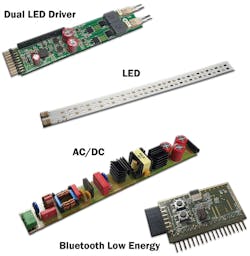LED Lighting Design Has Never Been Easier
Download this article in PDF format.
Application of LED lighting is more common these days, especially in homes and in some new buildings, as standard incandescent and fluorescent lighting continue to fade away. It’s not so dominant in older commercial and retail buildings or in industrial settings yet, but the trend is there. And with the new products available today, it’s become substantially easier to design and build industrial and new building lighting products and systems.
Lighting used to be so simple. You screwed a light bulb into a socket and applied ac and, voila’, light. Modern lighting now comes from a sophisticated semiconductor device called a light emitting diode (LED) with complex electronic circuits to power and control it. The rationale for this extra complexity and cost is electrical efficiency. LEDs provide the same if not more light intensity, but it’s far more efficient. It uses less energy and generates much less heat than older, more traditional lighting products.
In addition, most new LED lighting systems are of the connected type. Connected lighting is a rapidly growing segment within the Internet of Things (IoT) movement. The ability to control the lighting in wired and wireless systems is leading to significant energy savings.
New products are now available to simplify and speed up LED lighting design. ON Semiconductor has an LED lighting platform that facilitates the prototyping of new lighting solutions plus multiple options to provide the desirable connectivity and control.
Sponsored Resources:
- A Bright Future for Connected Lighting
- Connected Lighting - Power over Ethernet (POE) to DC
- LIGHTING-1-GEVK User Manual
An LED Lighting Platform
The availability of high-power white LEDs has made LED lighting practical. These devices require carefully conditioned dc power (e.g., precise constant current). To provide that, ON Semiconductor has developed both ac and dc sources, which are part of the company’s Lighting Development Platform. The platform contains all you need to prototype and finalize a design. The figure shows its main components.
The Lighting Development Platform consists of an LED module that contains a string of 16 warm white LEDs and 16 cool white LEDs. The two strings allow you to select the temperature of light best for the application. One type of LED puts out 121 lumens and the other 95 lumens. Total light output from this module is nearly 7000 lumens.
A dual string driver module using ON’s FL7760 LED drivers provides the constant 500-mA output current for each string. Its efficiency approaches 96%. This module has a dimming capability down to 0.6% using a 12-bit, 4000-increment pulse-width-modulation (PWM) approach. A telemetry feature allows for the monitoring of string current and voltage.
Another part of the development package is an ac-dc power board that accepts ac in the 90- to 270-V range and generates 55-V output with 70 W of available power. Power factor is 0.99 at full load. It uses ON FL7740 PSR flyback controllers with power factor correction (PFC). The board provides dc power to the driver board and the LEDs.
Connectivity Options
A wired alternative is a Power over Ethernet (PoE) connection. An Ethernet IEEE 802.3bt-compliant PoE module is also available. It furnishes an output voltage of 56 V for both the LEDs and the driver board with a power capability of up to 90 W. The module uses ON Semi’s NCP1096 IC designed for PoE powered devices (PDs).
Another option is the Bluetooth Low Energy (BLE) module that implements on-off and brightness level control by way of the 4000-increment dimming control capability. This module is based on the ON RSL10 Bluetooth product line. A telemetry service provides monitoring output voltage and current on the driver module. Bluetooth now includes a mesh capability if needed.
An alternate wireless product is the Zigbee Green Power product. It leverages ON Semi’s NCS36510 IC in a module that can use Zigbee mesh capability and the Thread development platform. This IC is a flexible IEEE 802.15.4-compliant standard that can be easily customized to create a proprietary wireless controller if needed.
ON Semi’s lighting platform, designated LIGHTING-1-GEVK, is available through Digi-Key.
Sponsored Resources:
About the Author

Lou Frenzel
Technical Contributing Editor
Lou Frenzel is a Contributing Technology Editor for Electronic Design Magazine where he writes articles and the blog Communique and other online material on the wireless, networking, and communications sectors. Lou interviews executives and engineers, attends conferences, and researches multiple areas. Lou has been writing in some capacity for ED since 2000.
Lou has 25+ years experience in the electronics industry as an engineer and manager. He has held VP level positions with Heathkit, McGraw Hill, and has 9 years of college teaching experience. Lou holds a bachelor’s degree from the University of Houston and a master’s degree from the University of Maryland. He is author of 28 books on computer and electronic subjects and lives in Bulverde, TX with his wife Joan. His website is www.loufrenzel.com.

